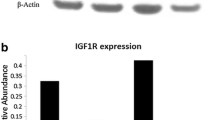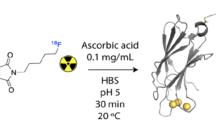Summary
In a previous study, we demonstrated the existence of a 3.2 ± 0.2 ppm peak in the1H NMR spectrum at 60 MHz from human pancreatic adenocarcinomas (Capan-1 cell) heterotransplanted intonude mice. This peak, which is not present in normal human pancreas, was attributed to enhanced membrane fluidity and/ or an increase in phospholipid turnover. The present study was designed to identify this signal by comparing the1H NMR spectra recorded in vivo at 100 MHz from Capan-1 tumors, after suppression of the tissular water proton peak, to those recorded from normal pancreatic tissue, and to those recorded at 300 MHz from lipid extracts. The1H NMR spectra at 100 MHz of the Capan-1 tumors in vivo exhibited three main peaks in the 3.2 ± 0.2 ppm region: 1. A peak at 2.8 ± 0.1 ppm from CH2 protons of the acyl chains of unsaturated phospholipids; 2. A peak at 3.2 ± 0.1 ppm from the protons of the N(CH3)3 group of choline; and 3 A peak at 3.5 ± 0.1 ppm attributed to GPC.
The NMR1H 300 MHz spectrum of phospholipid extracts of Capan-1 tumors displayed 12 principal resonances, of which only the N(CH3)3 peak of PC had a similar chemical shift to that observed at low resolution (3.2 ± 0.2 ppm). This peak had a higher intensity in the xenografts than in normal human pancreatic tissue. HPLC analysis of the same lipid extracts from Capan-1 cells in culture, of tumors derived from these cells and from normal pancreas showed: 1. Identical concentrations of the different phospholipids from cancerous human pancreatic cells in vivo and in culture; and 2. A significantly higher level of PC in the extracts of normal human pancreatic tissue.
The increase in intensity of the N(CH3)3 peak of PC in the Capan-1 tumors was not thought to be caused by an increase in PC concentration, but to a difference in conformation or mobility of the PC protons in the xenografts. The increase in relaxation time in cancerous tissue (from 60 to 125 ms) was also taken to be evidence in favor of a high mobility of protons. The peak observed at 3.2 ± 0.2 ppm in the low resolution NMR spectra from the Capan-1 tumors in vivo thus represents a combination of several phenomena: 1. An
Similar content being viewed by others
Abbreviations
- DAG:
-
diacylglycerol
- GPC:
-
glycerophosphorylcholine
- HPLC:
-
high performance liquid chromatography
- PC:
-
phosphatidylcholine
- PE:
-
phosphatidylethanolamine
- PI:
-
phosphatidylinositol
- PS:
-
phosphatidylserine
- NMR:
-
nuclear magnetic resonance
- TMS:
-
tetramethylsilane
- VOI:
-
volume of interest
References
Go VLM and DiMagno EP. Pancreatic exocrine adenocarcinoma.Br J Hosp Med 1977; 18: 567–576.
Fitzgerald PJ. Pancreatic cancer. The dismal disease.Arch Pathol Lab Med 1981; 100: 513–515.
Bruhn H, Frahm J, Gyngell ML, Merboldt KD, Hanicke W, Sauter R, Hamburger C. Noninvasive differentiation of tumors with use of localized H-l MR spectroscopy in vivo: initial experience in patients with cerebral tumors.Radiology 1989; 172: 541–548.
Glickson JD. Clinical NMR spectroscopy of tumors: current status and future directions.Invest Radiol 1989; 24: 1011–1016.
Damadian R. Tumor detection by nuclear magnetic resonance.Science 1971; 171: 1151–1153.
Stark DD, Moss AA, Goldberg HI, Davis PL, Federle MP. Magnetic resonance and CT of the normal and diseased pancreas: a comparative study.Radiology 1984; 150: 153–162.
Haaga JR. Magnetic resonance imaging of the pancreas.Radiol Clin North Am 1984; 22: 869–877.
Lee JKT, Heiken JP, Dixon WT. Detection of hepatic metastases by proton spectroscopic imaging.Radiology 1985; 156:429–433.
Chen W, Frazer JW, Dennis L, McBride CM, Boddie AW. Proton magnetic resonance spectral patterns of metastasizing and nonmetastasizing human colon cancer.Arch Surg 1987; 122: 1284–1288.
May GL, Wright LC, Holmes KT, Williams PG, Smith ICP, Wright PE, Fox RM, Mountford CE. Assignment of methylene proton resonances in NMR spectra of embryonic and transformed cells to plasma membrane triglyceride.J Biol Chem 1986; 261: 3048–3053.
Mountford CE, Grossman G, Reid G, Fox RM. Characterization of transformed cells and tumors by proton nuclear magnetic resonance spectroscopy.Cancer Res 1982; 42: 2270–2276.
Mountford CE, Grossman G, Gatenby PA, Fox RM. High-resolution proton nuclear magnetic resonance: application to the study of leukaemic lymphocytes.BrJ Cancer 1980; 41: 1000–1003.
Murat C, Esclassan J, Daumas M, Levrat JH, Palevody C, Vincensini PD, Hollande E. Enhanced membrane phospholipid metabolism in human pancreatic adenocarcinoma cell lines detected by low-resolution1H nuclear magnetic resonance spectroscopy.Pancreas 1989; 4: 145–152.
Jamieson JD. The secretory process in the pancreatic exocrine cell: morphologic and biochemical aspects, Jorpes JH, Mutt V, eds.,Secretin, Cholecystokinin, Pancreazymin and Gastrin. Springer-Verlag, Berlin, Heidelberg, New York, 1973,.
Esclassan J, Murat C, Aired S, Vincensini P, Hollande E. Demonstration of a new resonance peak by proton NMR in rat pancreas stimulated with cerulein.Pancreas 1990; 5: 580–588.
F:ögh J, Fögh JM, Orfeo T. One hundred and twenty- seven cultured human tumor cell lines producing tumors innude mice.J Natl Cancer Inst 1977; 59: 221–226.
Folch J, Lees M, Sloane Stanley GH. A simple method for the isolation and purification of total lipids from animal tissues.J Biol Chem 1957; 226: 497–508.
Connelly A, Counsell C, Lohman JAB, Ordige RJ. Outer volume suppressed image related in vivo spectroscopy (OSIRIS), a high-sensitivity localization technique.J Magn Res 1988; 78: 519–525.
Hore PJ. Solvent suppression in Fourier transform nuclear magnetic resonance.J Magn Res 1983; 55: 283–300.
Agris PF, Campbell ID. Proton nuclear magnetic resonance of intact Friend leukemia cells: phosphorylcholine increase during differentiation.Science 1982; 216: 1325–1327.
Bell JD, Brown JCC, Kubal G, Sadler PJ. N.M.R. invisible Iactate in blood plasma.FEBS Lett 1988; 235: 81–86.
Evanochko WT, Sakai T, Ng TC, Krishna NR, Kim HD, Zeidler RB, Ghanta VK, Brockman RW, Schiffer LM, Braunschweiger PG, Glickson JD. N.M.R. study of in vivo RIF-1 tumors: analysis of perchloric acid extracts and identification of1H,31P and13C resonances.Biochim Biophys Acta 1984; 805: 104–116.
Maxwell RJ, Prysor-Jones RA, Jenkens JS, Griffiths JR. Vasoactive intestinal peptide stimulates glycolysis in pituitary tumours;1H-N.M.R. detection of Iactate in vivo.Biochim Biophys Acta 1988; 968: 86–90.
Sparling ML, Zidovetzki R, Muller L, Chan SI. Analysis of membrane lipids by 500 MHz1H NMR.Anal Biochem 1989; 178:67–76.
Bernett JT, Meredith NK, Akins JR, Hannon WH. Determination of serum phospholipid metabolic profiles by high-performance liquid chromatography.J Liq Chromatogr 1985; 8: 1573–1591.
Chen SSH, Kou AY. Improved procedure for the separation of phospholipids by high-performance liquid chromatography.J Chromatogr 1982; 227: 25–31.
Hauser H and Gains N. Spontaneous vesiculation of phospholipids: a simple and quick method of forming unilamellar vesicles.Proc Natl Acad Sci USA 1982; 79: 1683–1687.
Pelech SL and Vance DE. Signal transduction via phosphatidylcholine cycles.Trends Biochem Sci 1989; 14: 28–30.
Palevody C, Dupont MA, Hollande E, Rao R, Commenges G, Haran R. Analyse par resonance magnetique nucleaire (RMN) et microscopie electronique de cellules pancreatiques cancereuses humaines: etude comparative.Biol Cell 1983; 49: 33a.
Moscat J, Cornet ME, Diaz-Meco MT, Larrodera P, Lopez-Alanon D, Lopez-Barahona M. Activation of phosphatidylcholine-specific phospholipase C in cell growth and oncogene transformation.Biochem Soc Trans 1989; 17:988–991.
Bell JD, Sadler PJ, Macleod AF, Turner PR, La Ville A.1H NMR studies of human blood plasma: assignment for resonances for lipoproteins.FEBS Lett. 1987; 219: 239–243.
Fernandez Y, Cambon-Gros C, Deltour P, Muntane J, Canal MT, Mitjavila S. Dietary polyunsaturated fatty acid deficiency: consequences for Ca2+ transport by hepatic microsomal membranes in relation with their physicochemical state.Food Add Contamin 1990; 7: S158-S161.
Christon R, Fernandez Y, Cambon-Gros C, Periquet A, Deltour P, Leger CL, Mitjavila S. The effect of dietary essential fatty acid deficiency on the composition and properties of the liver microsomal membrane of rats.J Nutr 1988; 118: 1310–1318.
Author information
Authors and Affiliations
Rights and permissions
About this article
Cite this article
Chemin-Thomas, C., Esclassan, J., Palevody, C. et al. Characterization of a specific signal from human pancreatic tumors heterotransplanted into nude mice. Int J Pancreatol 13, 175–185 (1993). https://doi.org/10.1007/BF02924438
Received:
Revised:
Accepted:
Issue Date:
DOI: https://doi.org/10.1007/BF02924438




